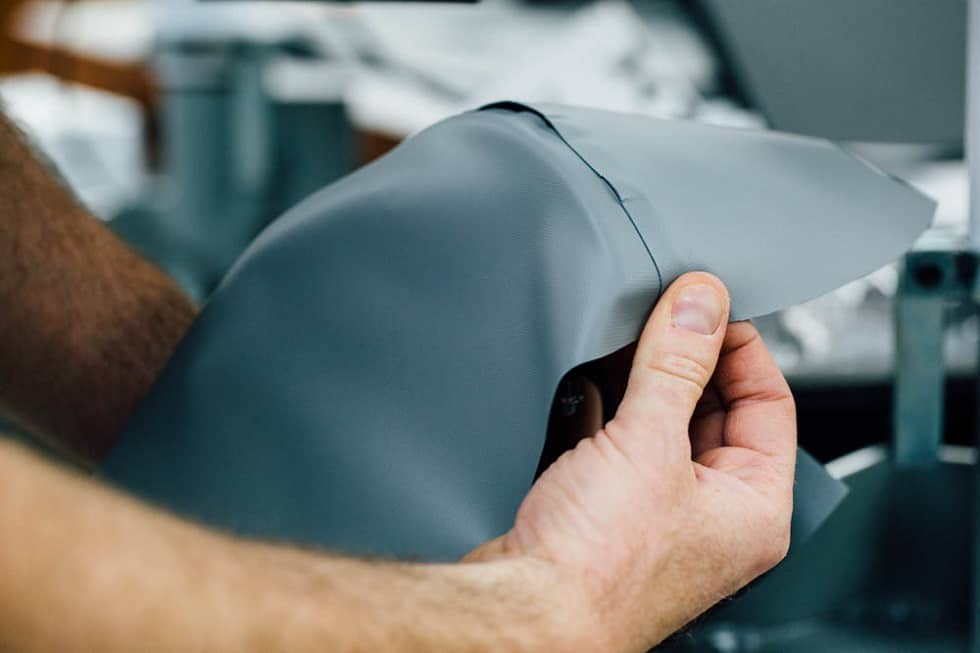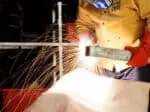Although we already have a solid idea about what type of protective clothing or PPE welders should wear while working, we rarely talk about the type of clothes they should avoid for their safety.
As a welder, you must be careful about what you wear when working on welding tasks. Your safety is your primary responsibility, so make sure your garments protect you from UV rays, burns, and other potentially dangerous substances.
It is not advisable to wear nylon clothes while welding because it is a synthetic fabric that shrinks when burned. It can readily catch fire with a single spark and adheres to the skin and aggravates the burns. Even after the fire has been out, nylon fibres remain stuck to the flesh, causing more harm.
Therefore, it is always advisable to wear natural fabrics like cotton, leather or wool while welding.
Also, there is a whole range of welding gears and protective PPE suitable for welding work, which will not aggravate the danger but rather protect you from any impending harm.
So, what fabrics are preferable while welding?
To protect oneself against UV radiation, open flames, sparks, and hot metal, welders should wear clothing that is heavyweight, densely woven, or composed entirely of cotton or wool.
However, leather is also an excellent fabric that acts as an electrical insulator which is quite useful in welding work. You can wear leather aprons to protect your chest and lap whether standing or sitting.
According to ANSI Z49.1-2012, “suitable protective apparel for every welding or cutting operation will vary with the size, type, and location of the work to be done.
Clothing must provide adequate covering and be manufactured of appropriate materials to reduce skin burns caused by sparks, splatter, or radiation. To guard against UV and infrared ray flash burn, it is suggested that all areas of the body be covered.”
To decrease reflection behind a face shield, use dark clothes. Wool garments, strong cotton, and leather are recommended because they resist degradation.
Materials that might melt or cause serious burns owing to sparks lodged in rolled-up sleeves, coat pockets, or trouser cuffs are not recommended.
Welding clothing/PPE
Welding gear is a form of personal protective equipment (PPE) that uses fire-resistant and thermally insulating materials to shield welders from metal spray and intense heat.
The American Welding Society issued many suggestions for welding and cutting protective equipment in the year 2008.
Welding clothes, according to Safety and Health Fact, should allow for flexibility of movement while covering all regions of exposed skin.
Long-sleeved shirts and slacks that cover the tops of your boots are advised. The fabric should be thick cotton or wool with no holes, rips, or frayed edges. If water, grease, oil, or solvent is spilled on welding clothes, it should be changed immediately.
Different fabrics suitable for welding gear
Cotton: Cotton welding apparel is an inexpensive way to protect yourself from flames, sparks, and molten splash. Fire Retardant (FR) cotton has been chemically treated to be heat resistant.
Cotton fabric dresses are a lighter, more breathable alternative to leather. For up to 50 washings, the material stays flame resistant.
Leather: Welding leather apparel is constructed of high-quality strong side split cow leather. Chrome tanned for softness and durability, as well as resistance to heat, sparks, slag, and cuts. All seams are made with Kevlar thread and double lock stitched.
Denim: While not ideal for welding activities, denim is a thick, robust cloth that will protect welders in low-volume, low-intensity operations. (What Kind of Jeans Do Welders Wear?)
Rubber: Although rubber is not typically used in welding jackets or caps, it is utilised in welding chaps, boots, aprons, and boot covers.
Flame retardant clothes for welding
All materials will catch fire, although some are more flammable than others.
Untreated natural fibres, such as cotton, linen, and silk, burn faster than wool, which is more difficult to ignite and has a low flame velocity. The weight and texture of the cloth influence how quickly it will ignite and burn.
Fabrics with a tight weave, such as wool, modacrylic, 100% polyester, and those that have been flame-retardant treated, are ideal.
Heavy, tight-weave textiles burn more slowly than light, loose-weave fabrics of the same substance. The flammability of a cloth is also affected by its surface roughness.
The majority of synthetic textiles, such as nylon, acrylic, or polyester, are resistant to ignition. When natural and synthetic fibres are combined, the risk increases because the combination of rapid rate of burning and fabric melting frequently results in severe burns.
Flame retardants applied by chemical treatment can lower the burning rates of curtains, drapes, and other household furnishings. Such post-manufacturing flame-retardant treatment is not approved for clothes.
Only conventional detergents should be used to clean flame-retardant materials. Clothing labels generally include enough information on how to care for the clothing.
To cut it short-
1.) Silk may be the most flammable, having a quick burning rate that may be exacerbated by dyes and other colour additives.
2.) Cotton and linen have a high burning rate as well, however this can be mitigated by the use of flame-retardant chemical additives.
3.) Acetate and triacetate are as flammable as cotton, if not somewhat less so. They can, however, be rendered flame-retardant by chemical treatment.
4.) Nylon, polyester, and acrylic are sluggish to burn, but once ignited, they cause significant melting and leaking.
5.) Wool is relatively flame-resistant. When lit, it normally burns slowly and may self-extinguish.
6.) Glass fibres and modacrylic are nearly flameproof. These synthetic fibres are developed and produced to be flame-resistant.
Conclusion
In all aspects of welding, ensure that every cloth is heat, flame, and spark resistant. Combustible materials should also be avoided in the fabric. You don’t want to be carrying anything that may be ignited by a spark.








